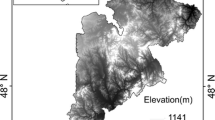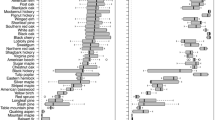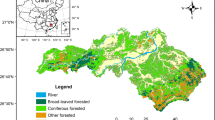Abstract
Context
Tree species distribution and abundance are affected by forces operating at multiple scales. Niche and biophysical process models have been commonly used to predict climate change effects at regional scales, however, these models have limited capability to include site-scale population dynamics and landscape-scale disturbance and dispersal. We applied a landscape modeling approach that incorporated three levels of spatial hierarchy (pixel, landtype, and ecological subsection) to model regional-scale shifts in forest composition under climate change.
Objective
To determine (1) how importance value of individual species will change under the PCM B1 and GFDL A1FI modeling scenarios and (2) how overall forest composition at different spatial scales will change under these climate change scenarios in the short, medium, and long term in the Central Hardwood Forest Region (CHFR).
Methods
We used LANDIS PRO to predict forest composition changes from 2000 to 2300 accounting for climate change, population dynamics, dispersal, and harvest in the CHFR. We analyzed forest composition shifts under alternative climate scenarios and at multiple spatial scales.
Results
Shifts in forest composition were greater under the GFDL A1FI than the PCM B1 modeling scenarios and were greatest at the scale of ecological sections followed by forest sub-regions and the whole CHFR. Forest composition shifted toward more southern and xeric species and lesser northern and mesic species.
Conclusions
We suggest it is essential to include site- and landscape-scale processes in models and to evaluate changes at multiple spatial and temporal scales when evaluating changes in species composition due to climate change and disturbance.




Similar content being viewed by others
References
Anderson-Teixeira KJ, Miller AD, Mohan JE, Hudiburg TW, Duval BD, Delucia EH (2013) Altered dynamics of forest recovery under a changing climate. Glob Chang Biol 19:2001–2021
Araújo MB, Luoto M (2007) The importance of biotic interactions for modeling species distributions under climate change. Glob Ecol Biogeogr 16:743–753
Araújo MB, Rahbek C (2006) How does climate change affect biodiversity. Science 313(5792):1396–1397
Bachelet D, Lenihan J, Drapek R, Neilson RP (2008) VEMAP versus VINCERA: a DGVM sensitivity to differences in climate scenarios. Glob Planet Chang 64:38–48
Bohlman S, Pacala S (2012) A forest structure model that determines crown layers and partitions growth and mortality rates for landscape-scale applications of tropical forests. J Ecol 100:508–518
Brandt L, He HS, Iverson LR, Thompson FR, Butler P, Handler S, Janowiak M, Shannon DP, Swanston C, Tirpak J, Walk J, Wang W, Watts L, Weigel D, Westin S (2014) Central hardwoods ecosystem vulnerability assessment and synthesis: a report from the central hardwoods climate change response framework project. General Technical. Reports. NRS-124. Newtown Square, PA: U.S. Department of Agriculture, Forest Service, Northern Research Station, p 254
Braun EL (1950) Deciduous forests of Eastern North America. Philadelphia: Blakiston
Burns RM, Honkala BH (tech. Coords.) (1990) Silvics of North America: 1. Conifers; 2. Hardwoods. Agriculture Handbook 654, USDA Forest Service, Washington, D.C., USA
Butler PR, Iverson L, Thompson FR, Brandt L, Handler S, Janowiak M, Shannon PD, Swanston C, Karriker K, Bartig J, Connolly S, Dijak W, Bearer S, Blatt S, Brandon A, Byers E, Coon C, Culbreth T, Daly J, Dorsey W, Ede D, Euler C, Gillies N, Hix DM, Johnson C, Lyte L, Matthews S, McCarthy D, Minney D, Murphy D, O’Dea C, Orwan R, Peters M, Prasad A, Randall C, Reed J, Sandeno C, Schuler T, Sneddon L, Stanley B, Steele A, Stout S, Swaty R, Teets J, Tomon T, Vanderhorst J, Whatley J, Zegre N (2015) Central Appalachians forest ecosystem vulnerability assessment and synthesis: a report from the central Appalachians climate change response framework project. General Technical. Reports. NRS-146. Newtown Square, PA: U.S. Department of Agriculture, Forest Service, Northern Research Station, p 310
Cleland DT, Freeouf JA, Keys JE, Nowacki GJ, Carpenter C, McNab WH (2007) Ecological subregions: sections and subsections of the conterminous United States [1:3,500,000] [CD-ROM]. In: Sloan AM (ed), Cartography General Technical Report WO-76. Washington, DC: U.S. Department of Agriculture, Forest Service
Corlett RT, Westcott DA (2013) Will plant movements keep up with climate change? Trends Ecol Evol 28:482–488
Dijak W (2013) Landscape builder: software for the creation of initial landscapes for LANDIS from FIA data. Comput Ecol Softw 3(2):17–25
Doxford SW, Freckleton RP (2012) Changes in the large-scale distribution of plants: extinction, colonization and the effects of climate. J Ecol 100:519–529
Elith J, Leathwick JR (2009) Species distribution models: ecological explanation and prediction across space and time. Annu Rev Ecol Evol Syst 40:677–697
Faith DP, Minchin PR, Belbin L (1987) Compositional dissimilarity as a robust measure of ecological distance. Plant Ecol 69:57–68
Fraser JS, He HS, Shifley SR, Wang WJ, Thompson FR (2013) Simulating stand-level harvest prescriptions across landscapes: LANDIS PRO harvest module design. Can J Forest Res 43:972–978
Gritti ES, Duputié A, Massol F, Chuine I (2013) Estimating consensus and associated uncertainty between inherently different species distribution models. Methods Ecol Evol 4:442–452
Guisan A, Thuiller W (2005) Predicting species distribution: offering more than simple habitat models. Ecol Lett 8:993–1009
He HS (2008) Forest landscape models, definition, characterization, and classification. For Ecol Manag 254:484–498
He HS, Mladenoff DJ (1999) Spatially explicit and stochastic simulation of forest landscape fire disturbance and succession. Ecology 80:81–99
He HS, Mladenoff DJ, Crow TR (1999) Linking an ecosystem model and a landscape model to study forest species response to climate warming. Ecol Model 114:213–233
He HS, Yang J, Shifley SR, Thompson FR (2011) Challenges of forest landscape modeling—simulating large landscapes and validating results. Landsc Urban Plan 100(4):400–402
IPCC (2007) The Physical Science Basis. In: Climate Change 2007: The Physical Science Basis. Contribution of Working Group I to the Fourth Assessment Report of the Intergovernmental Panel on Climate Change (eds Solomon S, Qin D, Manning M, Chen Z, Marquis M, Averyt KB, Tignor M, Miller HL). Cambridge University
Iverson LR, Prasad AM, Matthews SN, Peters M (2008) Estimating potential habitat for 134 eastern US tree species under six climate scenarios. For Ecol Manag 254:390–406
Iverson LR, Prasad AM, Matthews SN, Peters MP (2011) Lessons learned while integrating habitat, dispersal, disturbance, and life-history traits into species habitat models under climate change. Ecosystems 14:1005–1020
Johnson PS, Shifley SR, Rogers R (2009) The ecology and silviculture of Oaks, 2nd edn. CAB International, Oxfordshire
Kerhoulas LP, Kolb TE, Hurteau MD, Koch GW (2013) Managing climate change adaptation in forests: a case study from the U.S. Southwest. J Appl Ecol 50:1311–1320
Kubisch A, Poethke HJ, Hovestadt T (2011) Density-dependent dispersal and the formation of range borders. Ecography 34:1002–1008
Liang Y, He HS, Wang WJ, Fraser JS, Wu Z, Xu J (2015) The site-scale processes affect species distribution predictions of forest landscape models. Ecol Model 300:89–101
Little EL Jr (1971) Atlas of United States trees, volume 1, conifers and important hardwoods: U.S. Department of Agriculture Miscellaneous Publication 1146, p 9, 200 maps
Luo X, He HS, Liang Y, Wang WJ, Wu Z, Fraser JS (2014) Spatial simulation of the effect of fire and harvest on aboveground tree biomass in boreal forests of Northeast China. Landscape Ecol 29:1187–1200
McMahon SM, Harrison SP, Armbruster WS (2011) Improving assessment and modeling of climate change impacts on global terrestrial biodiversity. Trends Ecol Evol 26(5):249–259
McNab WH, Cleland DT, Freeouf JA, Keys JE, Nowacki GJ, Carpenter CA (2007). Description of “ecological subregions: section of the conterminous United States”. USDA Forest Service General Technical Report WO-76B, pp 1–57
Medvigy D, Wofsy SC, Munger JW, Hollinger DY, Moorcroft PR (2009) Mechanistic scaling of ecosystem function and dynamics in space and time: ecosystem demography model version 2. J Geophys Res 114:G01002. doi:10.1029/2008JG000812
Missouri Climate Center (2010) College of Agriculture, Food and Natural Resources, University of Missouri. http://climate.missouri.edu/news/arc/sep2009.php, http://climate.missouri.edu/news/arc/apr2010.php. Accessed 10 Jun 2010
Morin X, Thuiller W (2009) Comparing niche- and process-based models to reduce prediction uncertainty in species range shifts under climate change. Ecology 90(5):1301–1313
Morin X, Viner D, Chuine I (2008) Tree species range shifts at a continental scale: new predictive insights from a process-based model. J Ecol 96(4):784–794
National Oceanic and Atmospheric Administration-National Climatic Data Center (NOAA-NCDC) (2011). http://www7.ncdc.noaa.gov/. Accessed 1 July 2011
Neilson RP, Pitelka LF, Solomon AM, Nathan R, Midgley GF, Fragoso JMV, Lischke H, Thompson K (2005) Forecasting regional to global plant migration in response to climate change. Bioscience 55(9):749–759
Normand S, Zimmermann NE, Schur FM, Lischke H (2014) Demography as the basis for understanding and predicting range dynamics. Ecography 37:1149–1154
Oksanen JR, Kindt P, Legendre P, O’Hara B, Simpson GL, Solymos P, Stevens MHH, Wagner H (2009) Vegan: community ecology package. R package version 1.15-4. http://CRAN.R-project.org/package=vegan
O’Neill RV, DeAngelis D, Waide J, Allen TFH (1986) A hierarchical concept of ecosystems. Princeton University Press, Princeton
Pearson RG, Dawson TP (2003) Predicting the impacts of climate change on the distribution of species: are bioclimate envelope models useful? Glob Ecol Biogeogr 12:361–371
Pederson N, D’Amato AW, Dyer JM, Foster DR, Goldblum D, Hart JL, Hessl AE, Iverson LR, Jackson ST, Martin-Benito D, McCarthy BC, McEwan RW, Mladenoff DJ, Parker AJ, Shuman B, Williams JW (2014) Climate remains an important driver of post-European vegetation change in the eastern United States. Glob Chang Biol 21:2105–2110
Pigot AL, Tobias AT (2013) Species interactions constrain geographic range expansion over evolutionary time. Ecol Lett 16:330–338
Purves D, Pacala S (2008) Predictive models of forest dynamics. Science 320:1452–1453
R Development Core Team (2006) R: a language and environment for statistical computing, R Foundation for Statistical Computing, Vienna, Austria. http://www.R-project.org
Reich RB, Frelich L (2001) Temperate deciduous forests. Encyclopaedia of global environmental change, vol 2. Wiley, Chichester, pp 565–569
Schumacher S, Bugmann H (2006) The relative importance of climatic effects, wildfires and management for future forest landscape dynamics in the Swiss Alps. Glob Chang Biol 12:1435–1450
Soil Survey Staff, Natural Resources Conservation Service, United States Department of Agriculture. Database for Missouri. http://soils.usda.gov/. Accessed 1 Jun 2013
Stoner AMK, Hayhoe K, Yang X (2011) Downscaled climate projections by Katharine Hayhoe. http://cida.usgs.gov/climate/hayhoe_projections.jsp. Accessed 1 Nov 2011
Thompson JR, Foster DR, Scheller RM, Kittredge D (2011) The influence of land use and climate change on forest biomass and composition in Massachusetts, USA. Ecol Appl 21(7):2425–2444
Thornton PE, Thornton MM, Mayer BW, Wilhelmi N, Wei Y, Cook RB (2012) Daymet: Daily surface weather on a 1 km grid for North America, 1980–2012. Oak Ridge National Laboratory Distributed Active Archive Center, Oak Ridge, Tennessee, U.S.A. http://daymet.ornl.gov/. Accessed 1 July 2011
Thuiller W, Brotons L, Araújo MB, Lavorel S (2004) Effects of restricting environmental range of data to project current and future species distributions. Ecography 27:165–172
Thuiller W, Albert CH, Araújo MB, Berry PM, Cabeza M, Guisan A, Hickler T, Midgley GF, Paterson J, Schurr FM, Sykes MT, Zimmermann NE (2008) Predicting global change impacts on plant species distributions: future challenges. Perspect Plant Ecol Evol Syst 9:137–152
Vanderwel MC, Purves DW (2014) How do disturbances and environmental heterogeneity affect the pace of forest distribution shifts under climate change? Ecography 37:10–20
Wang WJ, He HS, Spetich MA, Shifley SR, Thompson FR III, Fraser JS (2013a) Modeling the effects of harvest alternatives on mitigating oak decline in a Central Hardwood Forest landscape. PLoS One 8(6):e66713. doi:10.1371/journal.pone.0066713
Wang WJ, He HS, Spetich MA, Shifley SR, Thompson FR III, Larsen DR, Fraser JS, Yang J (2013b) A large-scale forest landscape model incorporating multi-scale processes and utilizing forest inventory data. Ecosphere 4(9):106. doi:10.1890/ES13-00040.1
Wang WJ, He HS, Fraser JS, Thompson FR III, Shifley SR, Spetich MA (2014a) LANDIS PRO: a landscape model that predicts forest composition and structure changes at regional scales. Ecography 37:225–229
Wang WJ, He HS, Spetich MA, Shifley SR, Thompson FR (2014b) Evaluating forest landscape model predictions using empirical data and knowledge. Environ Model Softw 62:230–239
Wang WJ, He HS, Thompson III FR, Fraser JS, BB Hanberry, WD Dijak (2015) The importance of succession, harvest, and climate change in determining future forest composition changes in U.S. Central Hardwood Forests. Ecosphere (in press)
Woudenberg SW, Conkling BL, O’Connell BM, LaPoint EB, Turner JA, Waddell KL 2010. The Forest Inventory and Analysis Database: Database Description and Users Manual Version 4.0 for Phase 2. General Technical Reports RMRS-GTR-245. Fort Collins, CO: United States Department of Agriculture Forest Service, Rocky Mountain Research Station. 336 p
Wullschleger SD, Gunderson CA, Tharp ML, West DC, Post WM (2003) Simulated patterns of forest succession and productivity as a consequence of altered precipitation. In: Hanson PJ, Wullschleger SD (eds) North American temperate deciduous forest responses to changing precipitation regimes. Springer, New York, pp 433–446
Acknowledgments
This project was funded by the U.S.D.A. Forest Service Northern Research Station and Eastern Region, the Department of Interior USGS Northeast Climate Science Center graduate and post-doctoral fellowships, and the University of Missouri-Columbia.
Author information
Authors and Affiliations
Corresponding author
Additional information
Special issue: Macrosystems ecology: Novel methods and new understanding of multi-scale patterns and processes.
Guest Editors: S. Fei, Q. Guo, and K. Potter.
Rights and permissions
About this article
Cite this article
Wang, W.J., He, H.S., Thompson, F.R. et al. Landscape- and regional-scale shifts in forest composition under climate change in the Central Hardwood Region of the United States. Landscape Ecol 31, 149–163 (2016). https://doi.org/10.1007/s10980-015-0294-1
Received:
Accepted:
Published:
Issue Date:
DOI: https://doi.org/10.1007/s10980-015-0294-1




